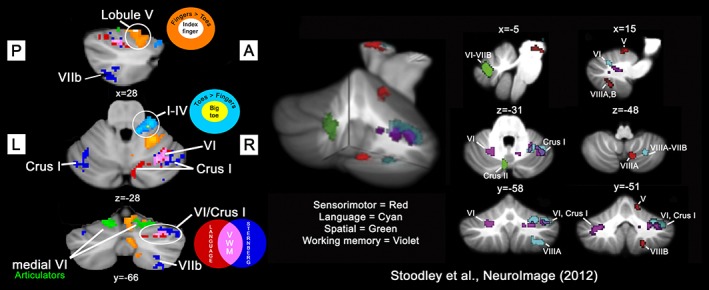Figure 5.

Composite cerebellar map demonstrating topology of sensorimotor and working memory/language function found in this study (on the left). Colour codings for each contrast/conjunction are shown as graphical summaries. For comparison, the results of a previous study (Stoodley et al., 2012) are also shown (on the right). The data obtained in the current study show convergence in both the sensorimotor and cognitive domains. Activity due to passive sensory stimulation of the index finger (white) and big toe (yellow) overlapped with that arising from flexion/extension of the fingers (orange) and toes (light blue), respectively, in the ipsilateral anterior and posterior cerebellar hemisphere. Language (conjunction of language contrasts, red) and Sternberg (linearly increased activity during maintenance of working memory, blue) tasks primarily activated right cerebellar structures. These cognitive tasks also showed a degree of overlap (assessed using a conjunction, pink) in right Crus I/Lobule VI: the putative verbal working memory (VWM) area of the cerebellum. Note that to facilitate visual comparison between studies, data from the current study were flipped horizontally. Statistical maps (including conjunctions) were determined with a cluster forming threshold of Z > 3.09 and corrected significance level of p < .05, with the exception of contrasts based on vibrotactile stimulation (p < .005 uncorrected). (Insert: Stoodley et al., 2012, fig. 1. Reproduced with permission.) [Color figure can be viewed at http://wileyonlinelibrary.com]
